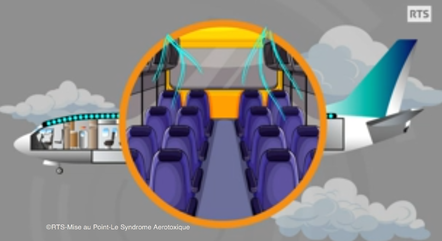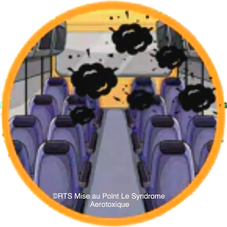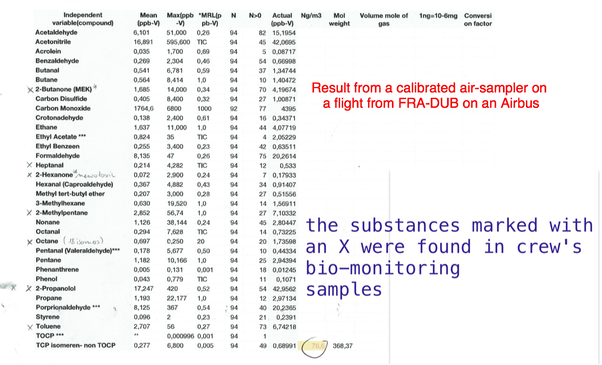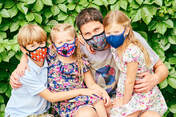|
What are Fume Events and what is Aerotoxic Syndrome? Intruduction Aerotoxic Syndrome is a term used to "bundle" the adverse health effects, especially those experienced by aircrew, following chronic exposure to toxic VOC pollution coming from 'pyrolysed' jet oil fumes. These fumes enter the cabin air via the engines' bleed-air. These events are called "fume events." In addition, more pollution gets into the cabin air from kerosene (refilling the aircraft) and carbon monoxide fumes during taxi from the "exhausts" behind other aircraft and on-blocks at gate positions. There is even more danger in the air through contact and inhalation of insecticide sprays, which are used for hygienic reasons and to and from certain countries. They are even sprayed inflight to kill off any form of insect. For all of which, the airlines have generally taken to using the terms "odours" or "smells". And of course, no harm. Aerotoxic Syndrome is the term given to the illness caused by exposure to contaminated air in jet aircraft (fumes/fume events). This term was first introduced in a published paper in 1999 jointly written by Dr. Harry Hoffman (†) of the U.S., Professor Dr. Chris Winder (†) of Australia, and Jean-Christophe Balouet PhD (†) of France.  click to view documentary by RTS (French) click to view documentary by RTS (French)
How is the air contaminated?
A supply of pressurized air is required by humans to sustain life at high altitude. This air is supplied directly from the compressor section of the jet engine and is known as ‘bleed air‘. Unfiltered bleed air is mixed inside the aircraft with already recirculated cabin air at a ratio of 50/50. Although the recirculated air is subsequently filtered, all of the bleed air which originates from the jet engines is unfiltered. Here you can views EASA's List of 127 toxic substances and the more recent updated version - 317 substances - detected by Jean-Christophe Balouet PhD HERE. |
|
Jet engines operate at higher temperatures and therefore use synthetic chemicals in oils. “Wet seals” are used to keep the oil and bleed air apart, but these seals "leak by design", which allows small amounts of oil to enter the bleed air. Furthermore, seals like any mechanical component slowly wear out and their efficiency then gradually declines, thus allowing more and more oil into both the cockpit and cabin air.
The seals are not really seals, they are rather controlled leakage devices and can suddenly fail completely resulting in visible or invisible toxic fumes/ smoke entering the cabin and/or the cockpit – this is known as a ' fume event’, but recently it is being termed an ‘odour event’ by the authorities and manufacturers who are eager to distract attention from a fundamental design flaw. |

These 'odours' sometimes smell like dirty socks: this is what causes that smell. The engine oils contain a percentage of highly toxic organophosphate additives as anti-wear agents. The oil becomes partially decomposed, i.e. chemically altered (‘pyrolysed’/ thermal degradation) due to the extremely high temperatures in the jet engine. Auxiliary Power Units (APU’s) also produce unfiltered bleed air and cause especially severe oil fume events (often visible), particularly after start up. Manufacturers have issued procedures: "BOEING decontamination procedure", "AIRBUS decontamination environmental control system", effectively putting the ball in the airlines' courts. Are they being followed?
In 1972 a Circular was published by the FAA with the title Carbon Monoxide (CO) Contamination in Aircraft, Detection, and Prevention. One paragraph is titled: "Is your aircraft a death trap?". Exposure to toxic fumes occurs not only via the mentioned bleed-air. Add to that: kerosene fumes that enter the cabin during on-blocks and taxi, flame-retardants in the interior materials and insecticides (onboard spraying = disinsection) all of which affect individuals in different ways. Various levels and types of toxic chemicals are present. The constant presence of "low-level" pollution and as such often not obvious to the senses, and the number of occurrences of a "fume event" which is usually more obvious by typical smells on any given flight, previous exposure history to contaminated air, their genetic make-up, age, possible medical conditions, and potentially any medication used (pharmaceuticals = chemicals) must be taken into consideration, all of which can contribute to crew and passengers ending up with "Aerotoxic Syndrome". See why here: TILT. 
Those who are subjected to toxic fumes usually complain first of headaches, breathing difficulties, muscle aching, sore itchy eyes & throat, dizziness, nausea, confusion - symptoms that appear as immediate "fight" reactions by the nervous system.
Many suffer full recurring poisoning symptoms - "Aerotoxic Syndrome" - after repeated and chronic exposures to such toxic substances and chemical mixtures. Many of these substances target the central nervous system (CNS). The CNS controls all of the major organs in the body; symptoms are mainly neurological but many other symptoms appear that mimic other illnesses. Many of the chemicals are carcinogenic!
Aerotoxic Syndrome is frequently misdiagnosed and mistreated by doctors who are unfamiliar with a hidden cause of poisonings. This often results in patients being treated with i.e., anti-depressants, antibiotics, anti-inflammatories, and other drugs. "Health Effects after Fumes Exposure," view a presentation here. Indoor pollution can be worse than outdoor pollution! And in an aircraft which is a more or less sealed environment and no window or door can be opened - no escape route is given. So-called 'jet lag' is caused by crossing time zones. A one-off acute poisoning or repeated low-level exposures to these fumes can produce more and sometimes indistinguishable symptoms called 'jet lag'. Very few victims will work out the cause of their ill health, since being 'gassed' is subtle, mostly invisible, and certainly not expected. Despite repeated calls by dedicated organizations, still, no sensors for gas/ CO or other substances' detection have been fitted in modern jets, not to mention effective filters. Calls for 'more training of the crew' do not make sense since the question is: what for training? Once the fumes ('odors') are present, there is nothing much one can do other than don a professional type respirator mask, which are not available for cabin crew, never mind passengers! The pilots at least have their full-face oxygen masks for emergency protection. And what type of training is required to avoid constant low-level pollution? Many former aircrew who became victims speak of feeling like 'zombies,' or being in a 'vegetative state' or 'permanently intoxicated.' Also, passengers have experienced from single 'incidents' acute and severe poisonings - one such testimony can be read here. 'Aerotoxic Syndrome, the poisoning of Airline Pilots, Cabin Crew and Passengers that is possible in any air flight' by Dr. Sarah Myhill can be read here. If you have flown on an airliner and have experienced unexplained ill-health symptoms, please go to our regularly updated: ADVICE page. Cited articles linked within the text:
|

TIP for MASKS: protect yourself by using a high quality pollution mask. Choose one for yourself and your family at www.cambridgemask.com's 'OUR OWN STORE' or AMAZON.com. Enter the code FLYERSFRIEND upon checking out and receive a 10% reduction, courtesy Aerotoxic Team. Go to website.
|



